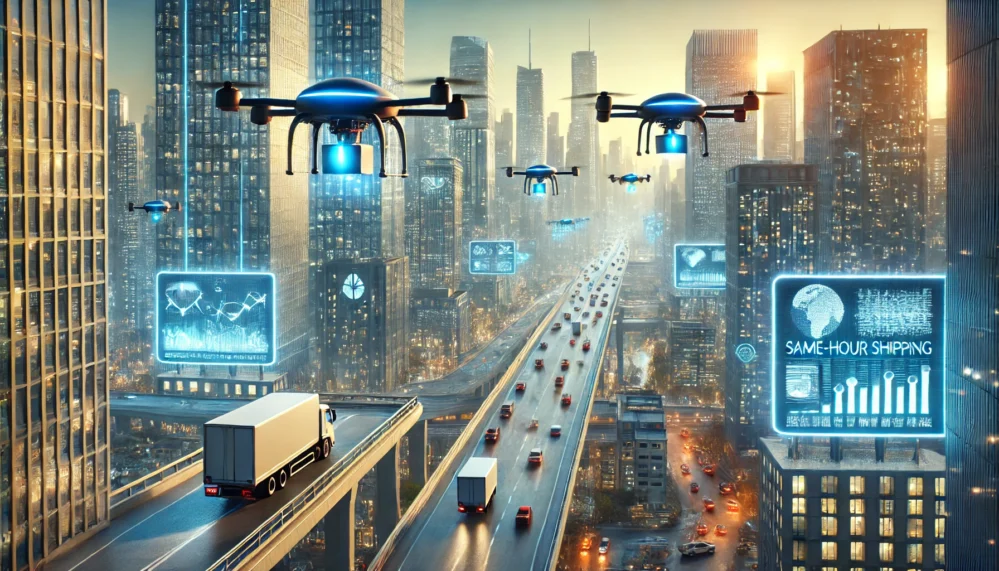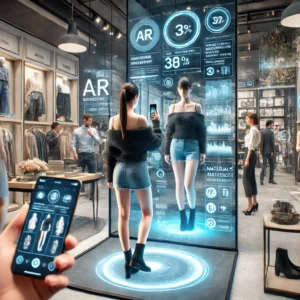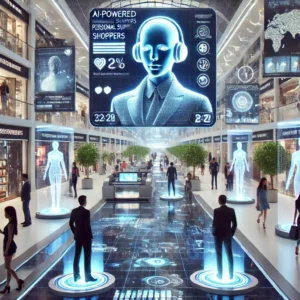
Imagine the convenience of having your favorite gadget, a steaming hot meal, or even those last-minute essentials delivered to your door within the hour—courtesy of buzzing drones weaving through city skylines. Urban Drone Delivery Services are transforming our urban landscapes, promising not just speed but a radical overhaul in logistics. This futuristic trend, already stirring debates in government corridors, research labs, and boardrooms, is reshaping how we receive goods in our fast-paced world.
The New Age of Urban Logistics
The hustle of city life demands efficiency. Traditional delivery methods, with their clogged roads and inevitable delays, are slowly being outpaced by innovative drone fleets. Picture this: a fleet of state-of-the-art drones, each outfitted with advanced navigation systems and AI-powered logistics software, zipping above the congested urban sprawl to ensure same-hour shipping. This isn’t merely a nod to science fiction; it’s the dawning reality of urban logistics.
These drones offer a dual promise: dramatically reduced delivery times and lower carbon footprints. Companies are leveraging this technology to bypass traffic jams and reduce delivery-related emissions. While some urban dwellers still find the idea a tad surreal, industry insiders and tech aficionados agree—the days of waiting days for your order are numbered.
Yet, as with any transformative technology, the journey is not entirely smooth. There are moments of jittery anticipation, a touch of nostalgia for the simplicity of yesteryears, and even a dash of skepticism about safety and reliability. And honestly, isn’t that mix what makes any major change so exhilarating?
Government Regulations and Political Debates
No technological revolution ever sails smoothly without navigating the murky waters of regulation. Governments worldwide are now wrestling with how best to integrate Urban Drone Delivery Services into existing airspace. Regulatory bodies like the Federal Aviation Administration (FAA) in the United States are actively drafting rules to ensure that drones don’t turn our skies into chaotic battlegrounds. These guidelines focus on safety, privacy, and operational limits, ensuring that drones remain a boon rather than a bane.
Political debates often reflect a tug-of-war between innovation and control. In Europe, for instance, policymakers are keen to promote technologies that could stimulate economic growth but are equally cautious about potential privacy infringements and airspace safety. Headlines in reputable outlets such as Reuters and Bloomberg frequently spotlight these discussions, where one side champions relaxed regulations to accelerate growth while the other insists on tighter oversight to safeguard public interests.
In many ways, these political maneuvers are reminiscent of an old dance—between the drive to innovate and the necessity of regulation. The controversy itself is a sign of progress, as governments gradually adjust their frameworks to support this promising technology without compromising public safety.
Research Breakthroughs: From Lab to Sky
Behind every soaring drone lies an intricate web of research and development. Cutting-edge innovations in battery technology, obstacle detection, and real-time route optimization are born in the labs of leading institutions. Universities like MIT and Stanford are at the forefront, collaborating with private enterprises and government agencies to push the limits of what drone technology can achieve.
Recent studies published in scientific journals and showcased at tech symposiums reveal that integrating artificial intelligence (AI) into drone navigation systems has been a game-changer. These advancements enable drones to autonomously adjust their flight paths in response to unexpected obstacles—be it a sudden gust of wind or an unforeseen urban event. Funding from government initiatives and private venture capital is fueling these breakthroughs, ensuring that each iteration of drone technology is safer and more efficient than its predecessor.
Such research is not confined to elite academic circles. Independent labs and startups are also chipping away at the challenges of urban drone delivery. For example, collaborative projects between tech companies and municipal governments have resulted in pilot programs that test drones’ capabilities in real-life urban environments. It’s a vibrant mix of trial, error, and triumphant success stories—a veritable laboratory of innovation unfolding right above our heads.
Celebrity Buzz and Social Media Chatter
In the age of social media, celebrities and influencers have become the unexpected ambassadors of drone delivery technology. Visionaries like Elon Musk have openly mused about a future where drones dominate urban logistics, suggesting that these aerial couriers are not just a passing fad but an inevitable reality. His tweets and interviews, sprinkled with futuristic optimism, often set off waves of online discussion, stirring both excitement and critique.
Conversely, other celebrities have taken a more measured stance. Leonardo DiCaprio, for instance, has raised concerns about the environmental and privacy implications of widespread drone use, urging companies to focus on sustainable practices. These divergent views contribute to the vibrant social discourse, making drone delivery a topic that resonates across various demographics.
Social media platforms are abuzz with user-generated content—videos of drone test flights, live streams of urban deliveries, and memes that humorously juxtapose futuristic technology with everyday inconveniences. This digital buzz not only enhances public engagement but also reinforces the cultural significance of Urban Drone Delivery Services in our collective imagination.
Perspectives Across Generations
The reception of urban drone delivery is as varied as the city’s population itself. Among tech-savvy millennials and Gen Z, the idea of receiving packages via drone is met with enthusiastic curiosity and excitement. For these younger generations, drones epitomize modernity—a symbol of a connected, on-demand future where waiting is a relic of the past.
In stark contrast, many older citizens express a cautious skepticism. The notion of buzzing drones overhead can evoke a mix of nostalgia and concern. Some worry about the potential risks: What happens if a drone malfunctions? Could it invade personal privacy? Yet, there is also a grudging appreciation for the efficiency these systems promise. Many seniors acknowledge that, if executed responsibly, drone deliveries could reduce urban congestion and even contribute to a quieter, cleaner environment.
This generational divide underscores the complexity of societal change. While youth embrace technological leaps with open arms, older generations remind us of the need for caution and thorough vetting. Both perspectives, however, are invaluable in steering the evolution of Urban Drone Delivery Services toward a future that is inclusive and safe for all.
Global Business Impacts and Revenue Streams
Across the globe, businesses are waking up to the vast potential of drone delivery. Giants like Amazon, UPS, and DHL have already launched pilot projects, investing heavily in drone technology to revolutionize their last-mile delivery networks. According to market reports from sources like Forbes and Bloomberg, the drone delivery market is set to surge into a multi-billion-dollar industry within the next decade.
This isn’t just about cutting delivery times—it’s about reshaping the economic landscape. Startups and tech innovators are flocking to this nascent market, each vying to secure a slice of the lucrative revenue stream. As drones become an integral part of urban logistics, companies are poised to reap significant cost savings through reduced manpower and more efficient fuel usage. The ripple effects are profound: lower operational costs, increased customer satisfaction, and ultimately, a surge in profit margins.
Investors are paying close attention. Venture capital firms are channeling millions into promising drone delivery startups, betting that this technology will not only revolutionize logistics but also create entirely new business ecosystems. The convergence of technology and commerce in this space heralds an era where urban landscapes transform into dynamic hubs of innovation and entrepreneurial success.
Yet, with great opportunity comes equally great risk. The market’s rapid growth is tempered by regulatory uncertainties and technological challenges that could derail even the most well-funded ventures. As global businesses navigate these turbulent waters, the success of Urban Drone Delivery Services will hinge on a delicate balance between innovation, regulation, and public trust.
Navigating Challenges: Safety, Privacy, and Technology
Despite the palpable excitement, the road to mainstream drone delivery is riddled with challenges. Safety remains paramount. The idea of hundreds of drones buzzing over densely populated areas brings legitimate concerns about collisions, technical failures, and potential misuse. Recent incidents, though rare, have spotlighted the need for robust fail-safe mechanisms and real-time monitoring systems.
Privacy is another contentious issue. As drones capture aerial footage to navigate complex urban terrains, questions arise about data security and personal privacy. Communities and advocacy groups are increasingly vocal, urging companies to adopt stringent data protection measures. The balance between technological advancement and safeguarding individual rights is a delicate one—a puzzle that regulators, technologists, and citizens must solve together.
Weather unpredictability further complicates matters. Sudden storms or high winds can disrupt drone operations, leading to delays and, in worst-case scenarios, accidents. Engineers and researchers are tirelessly working on adaptive technologies that can help drones withstand these challenges. Innovations in battery life, sensor accuracy, and AI-powered decision-making are gradually addressing these issues, yet the quest for a foolproof system is ongoing.
The interplay between these challenges and opportunities creates an environment of constant evolution. Each setback is met with a new solution, every obstacle spurring further innovation. In this dynamic landscape, Urban Drone Delivery Services continue to push the boundaries of what’s possible, transforming potential pitfalls into stepping stones for future success.
A Glimpse into the Future
Peering into the horizon, the future of urban drone delivery appears both promising and unpredictable. Imagine a city where drones not only deliver packages but also coordinate with autonomous ground vehicles and integrated smart city infrastructure. This seamless connectivity could herald an era of unparalleled efficiency—where logistics, healthcare, and emergency services all benefit from rapid aerial delivery.
Researchers foresee a day when drones will autonomously switch between different tasks: from delivering urgent medications in a crisis to transporting food supplies during natural disasters. This level of versatility is being actively explored in collaborative projects between municipal governments and tech innovators. It’s an era where the sky isn’t the limit—it’s merely the beginning of a new chapter in urban living.
At times, the vision of such a future might seem overly ambitious, even disjointed. Yet, the gradual integration of drones into everyday urban life is already underway. Each successful flight, each timely delivery, contributes to a narrative of progress—a story of human ingenuity that bridges the gap between our present limitations and a future defined by speed, convenience, and connectivity.
The Human Element: Anecdotes and Reflections
Let’s get personal for a moment. Consider the story of Maya, a young professional living in a sprawling metropolis. For Maya, who juggles a hectic work schedule and a vibrant social life, the advent of drone delivery is nothing short of revolutionary. “I used to spend so much time waiting by the door, checking my phone for updates. Now, it’s like magic—the drone arrives, and I’m back to living my life,” she mused during a recent conversation with a local tech magazine. Her excitement mirrors the optimism of countless others who see these advancements as a means to reclaim precious time in their busy lives.
On the flip side, there’s Mr. Johnson, a retiree who has witnessed the evolution of urban life over decades. He often reminisces about the days when deliveries were made by friendly neighborhood couriers and expresses a hint of nostalgia for a slower, more personal pace. “I do worry sometimes about the constant hum of drones overhead,” he admits, “but I also see the benefits—less traffic, quicker services. It’s a strange mix of emotions.” These contrasting personal stories, spanning generations, highlight the multifaceted impact of Urban Drone Delivery Services on society.
Bridging the Gap: Community Engagement and Adaptation
As cities evolve, so too must the dialogue between technology providers and the communities they serve. Local governments and private companies are increasingly holding town hall meetings and public consultations to address residents’ concerns. These forums not only educate citizens about the safety protocols and technological advancements behind drone delivery but also allow for an open exchange of ideas. It’s in these conversations that a shared vision for a harmonious urban future begins to take shape.
Some communities have even initiated pilot projects, inviting residents to experience drone deliveries firsthand. The feedback has been a blend of awe, constructive criticism, and even humorous anecdotes about “the drone that almost missed my birthday cake!” Such interactions underscore the importance of community engagement in smoothing the path for this disruptive technology.
Business, Innovation, and Economic Transformation
At the heart of this revolution lies a potent mix of business ambition and relentless innovation. Global corporations are not just investing in drone fleets—they are reimagining the entire logistics ecosystem. The integration of drones into supply chains is already creating ripple effects across industries, from retail to pharmaceuticals.
For example, startups are emerging with niche solutions tailored to hyper-local deliveries in densely populated areas. Investors are pouring capital into these ventures, convinced that Urban Drone Delivery Services will redefine urban commerce. Market research by firms like Forbes suggests that the combined revenue of drone delivery could reach astronomical figures in the coming years, ushering in a new era of economic transformation.
This business evolution is not without its challenges. Competition is fierce, and the race to perfect drone technology has spurred a flurry of innovation and, occasionally, some missteps. But in this high-stakes game, each setback fuels further research, ensuring that the technology remains on a steep trajectory toward efficiency and reliability.
Balancing Innovation with Responsibility
In the whirlwind of technological progress, maintaining a sense of responsibility is crucial. Companies pioneering Urban Drone Delivery Services are increasingly adopting sustainable practices—be it through eco-friendly drone designs or carbon offset initiatives. Industry leaders are keenly aware that true innovation must go hand in hand with ethical responsibility.
Moreover, academic institutions and think tanks are conducting comprehensive studies on the societal impacts of drone technology. These research efforts are not merely academic; they inform policy decisions and help shape a regulatory environment that balances progress with prudence. The dialogue between innovators, regulators, and the public is ongoing—a dynamic process that ensures the benefits of drone delivery are realized without compromising safety, privacy, or community values.
FAQs on Urban Drone Delivery Services
Q1: What are Urban Drone Delivery Services?
A1: Urban Drone Delivery Services involve using unmanned aerial vehicles to transport goods quickly within urban environments, offering same-hour shipping through advanced logistics and AI-driven navigation.
Q2: How do government regulations affect drone deliveries?
A2: Agencies like the FAA establish safety and operational guidelines, balancing innovation with public safety and privacy concerns, while political debates continue to shape regulatory frameworks.
Q3: What are the primary challenges faced by drone delivery services?
A3: Key challenges include ensuring safety amid dense urban populations, managing weather unpredictability, addressing privacy concerns, and integrating new technologies into existing infrastructure.
Q4: How do different generations view drone deliveries?
A4: Younger generations typically embrace the technology for its speed and convenience, while older generations may be more cautious, citing concerns about safety, noise, and privacy.
Q5: What is the economic potential of drone delivery services?
A5: With major corporations investing and startups innovating, the drone delivery market is poised to become a multi-billion-dollar industry, transforming global supply chains and urban commerce.
Q6: Can drone deliveries be made sustainable?
A6: Yes, many companies are adopting eco-friendly designs and sustainable practices to ensure that the rapid growth of drone delivery technology aligns with environmental goals.
Final Thoughts: Embracing a Sky-High Future
In the grand tapestry of urban evolution, Urban Drone Delivery Services are more than just a technological novelty—they represent a profound shift in how we navigate modern life. As drones become a common sight in our cityscapes, they remind us that progress often comes with a mix of excitement, apprehension, and boundless possibility. Whether you’re a tech enthusiast marveling at the latest advancements or a cautious observer reflecting on the changes from a more traditional perspective, the future of urban logistics promises to be as dynamic as it is transformative.
The journey ahead will undoubtedly involve challenges, debates, and adjustments. Yet, as each drone takes flight, it carries with it not only packages but also the aspirations of a society eager to embrace efficiency, sustainability, and a touch of futuristic wonder.
For more insights on urban innovation and cutting-edge logistics, visit NewsWant’s Innovation Hub and join the conversation about the future of delivery in our ever-evolving cities.




